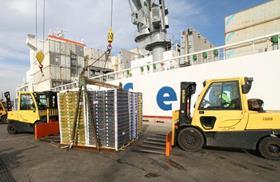
The Port of Wilmington in the US northeast had one of its most successful seasons ever for Chilean fresh fruit imports last season.
“Our volume from Chile increased by 36 per cent last season and we handled over 96,000 pallets of fruit,” the port’s executive director, Thomas Keefer, told Americafruit.
Wilmington, which handles handling 5m tonnes of cargo annually, is the leading terminal on the Delaware River and enjoys an advantageous position as the first port of call.
The facility is the number one seaport for fresh fruit imports in the US, the top banana port for North America and operates the largest on-dock cold storage complex in North America.
According to Keefer, it is the port’s state-of-the-art facilities, which help protect product quality, that are attracting more imported fruit arrivals.
“Three years ago, we installed a rapid cooling system capable of bringing down internal fruit temperature to between 0oC and 1oC, usually within three hours. Our table grape imports have been increasing steadily for the last several years, but last season our volume doubled!”
Wilmington is therefore a key port of call for Chilean and Brazilian table grapes, which both require fumigation. Peruvian grapes are also handled by the port.
The Moroccan citrus industry has exclusively used the Port of Wilmington for entry into North America for many years.
Thanks to “tremendous” improvements in logistics for Morocco in the last few years, Wilmington’s citrus imports from the African nation are also rising, according to Keefer,
“The biggest problem for Morocco was the risk of the 45-day transit time combined with the need for cold treatment,” says Keefer. “But they have been able to reduce the steaming time to the US to 25 days and last season cold treatment was conducted in transit, which allowed their fruit to enter the US distribution system in about 15 days from departure.
The Port of Wilmington saw the value of its Moroccan mandarin imports increase by 20 per cent last year, Keefer noted, while the industry’s overall seasonal production declined by 25 per cent.
The full report will be published in the October/November issue of Americafruit.



